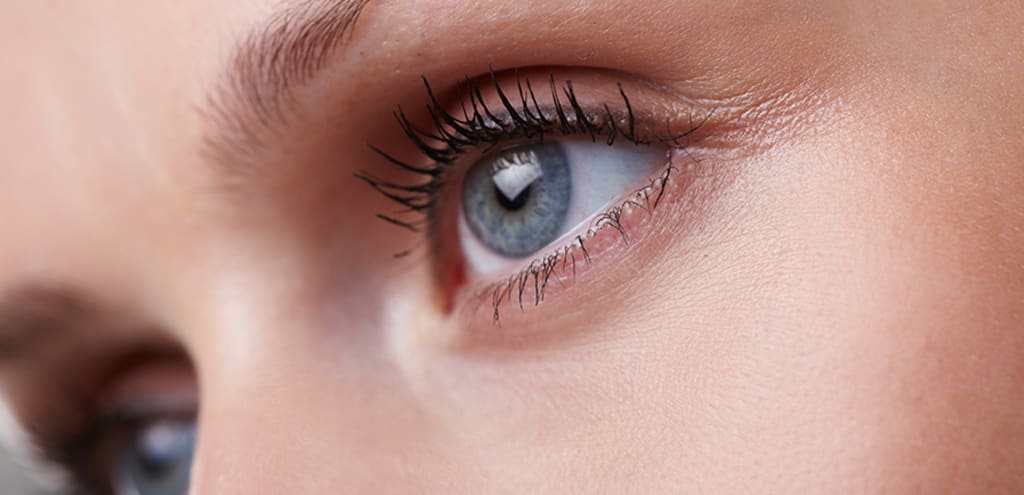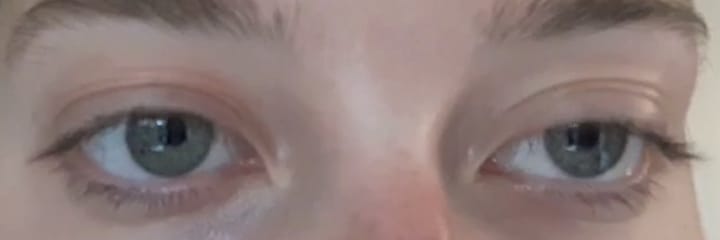Giving her the Beautiful Eyes, She used to have
Restoring Symmetrical eyelids that used to be Asymmetrical


There are certain human characteristics that seem to be purely subjective, like beauty. We as humans all evolved to desire feelings of worthiness and a sense of belonging that is brought about by many factors including cues indicating favorable overall health and longevity. Some of these cues “include age and physical condition, clear skin, dexterity, gait (as an indicator of locomotor health), and symmetry – especially facial symmetry.”1 William G. Allyn, Professor of Medical Optics, University of Rochester, said that “more than 50 percent of the cortex, the surface of the brain, is devoted to processing visual information.”
One study at UCLA indicated that up to 93 percent of communication effectiveness is determined by nonverbal cues. Another study indicated that the impact of a performance was determined 7 percent by the words used, 38 percent by voice quality, and 55 percent by nonverbal communication.2
This means that when communicating with another person, the primary instrument humans use for stimuli input, are the eyes. The eyes telegraph our health and communicational expressions. Any abnormalities in the ocular region will have significant emotional, psychological and social consequences. When people want to treat uneven eyelids, it is not only for the subjective cosmetic reasons pertaining to beauty – which is “highly influenced by public opinion, norms and esthetic trends in the society and specific time era”3 – but it is also for the satisfaction of our innate drive that we have become biologically selected for to choose symmetry, because it is a basic sign of having good genes. Humans want life partners with good genes. Humans want to communicate they have good genes with their eyes.

In life, we can experience many things such as the realization of material goals, reciprocal altruistic relationships, good health, and even a sense of optimism. However, regardless of these meaningful experiences, without passion to uniquely guide us as we grow, we’d feel a missing void in the depths of our hearts – that something we’d been waiting for have not arrived; that our inner seed have not yet flowered.
For me, my passion started when I realized just how similar we all really are. We have more things in common than different. Although we may look different, and are each eccentric as individuals, there are experiences we all perceive in the same way compared to other beings we co-exist with, in the home we’re privileged to, called Earth. We can all sense when one is treating another in a way one wouldn’t want to be treated.
I am lucky to have the kind of work, which facilitated the epiphany of us people having more similarities than differences and is resulting in the concomitant experience of continued personal growth. To me, this positive feedback loop represents the implicit constitution of what passion fundamentally is. Recalling this takes me back to September of 2018.

My work involves the restoration of people’s original eyelid creases using non-invasive methods. Currently, the mainstream way of addressing these types of problems, is to undergo a cosmetic surgery procedure. The solution I imagined in my mind, based on my early childhood experiences with self-experimentations on my own eyelid, is best described as an invention. But, being an invention means people’s response to admitting they used something so rare and brand new to fix something so personal, will mirror my own response, which kept the realization of my life’s work dormant for 10 years. In short, we wanted to keep it a secret that we cared so much about something like this – like the way our eyes looked – which can unavoidably ingulf us with feelings of insecurity, a preoccupation with oneself, especially with how others might perceive our appearance.
When I first saw her eyelids, and then briefly got to know her, I thought she was already beautiful. I recall thinking she didn’t need to do anything to be more beautiful. But I also remembered her telling me the uneven eyelids did bother her and although it may not be obvious to others, her experience dealing with the unevenness of her eyelids was just as real as the other cases I worked on from people of different ethnicity, namely those who are East Asian.
What I appreciated most from her was the developing trust she had in my invention by seeking to understand my work before judging. The wise teaching from the late Steven R. Covey, to seek to understand before you are understood, exemplifies why this is so helpful. She allowed me to attend parts of her personal daily life concerns, such as her make-up routine for her eyes, and with that introductory form of acceptance, my skill of fixing uneven eyelids was given space to mature and distill into its fundamental elements.


There were times when we both were in awe of the eyelid’s improving symmetry, despite knowing certain stressors were present which previously would have compromised the crease during the beginning stages. We rejoiced in knowing her trajectory to fully restoring the symmetry in her eyes was normal and that in just a few months, she wouldn’t have to worry about the wonky behavior of her eyelids coming back to her life.
And then there were the times when her ideal eyelid crease just kept under performing. The shared experience of us losing hope, like grains of sand slipping through our fingers, was almost like a bond that reminded us we couldn’t give up. It didn’t matter the experience was that of disappointment. It mattered that it was shared. As I looked into her eyes every morning while checking her videos to monitor progress, I knew the work was worth it to see her smile again to tell me she loves the look of her eyes and to experientially know to “never underestimate the power of a small group of committed people to change the world. In fact, it is the only thing that ever has,” as Margaret Mead put it.
She was the first Occidental eyelid person to keep in touch with me for an entire year, updating me diligently and showing great appreciation of the tapes I cut for her without receiving payment, and us doing this to discover knowledge we now give forward to others in need.

To share such experiences with those around the world that we encounter randomly, for a brief moment in time, where we care, cry together, rejoice in bliss, then depart, makes every present moment precious. And it’s this kind of passion that I would love to serve even more people in need of the help my wife and I are here to provide.
It would be so pragmatic to be able to offer a membership service to those who need my wife’s and my eyelid advising service. Sometimes, people need a sense that there is a real human at the end of the line caring for the same things they care for, and actively curating important information for others so to offer a convenient way to access this information which is currently scattered all over the internet in a disorganized fashion. We hope one day those reading this post can be inspired to let the spirit of helping consume their lives and bring smiles to the symmetric eyes that used to hold them back when they were asymmetric.

WORKS CITED:
1. MacNeill A D. Evolutionary Psychology I: The Science of Human Nature. Narrated by Allen D. MacNeill, Recorded Books, 2010. Audiobook.
2. Heathfield S M. Tips for Understanding Nonverbal Communication: Listen With Your Eyes. The Balance. 2017.
< https://www.thebalance.com/tips-for-understanding-nonverbal-communication-1918459 >
3. Ferraro, G.A., Rossano, F., & Andrea, F. Self-perception and Self-esteem of Patients Seeking Cosmetic Surgery, Aesthetic Plastic Surgery, 2005; 103, 83-89.
About the Creator
Enjoyed the story? Support the Creator.
Subscribe for free to receive all their stories in your feed. You could also pledge your support or give them a one-off tip, letting them know you appreciate their work.






Comments
There are no comments for this story
Be the first to respond and start the conversation.